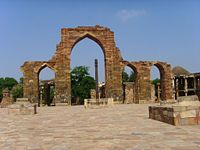Qutb-ud-din Aybak
Qutb-ud-din Aybak (Persian / Urdu: قطب الدین ایبک) was a Turkic ruler of medieval India, the first Sultan of Delhi and founder of the Slave dynasty (also known as the Ghulam dynasty). He served as sultan for only four years, from 1206 to 1210.
Early years
Qutb-ud-din was born somewhere in Central Asia; he was of Turkic descent.[1][2] While still a child he was captured and sold as a slave (ghulam). He was purchased by the chief Qazi of Nishapur, a town in the province of Khorasan in northeastern Iran. The Qazi treated him like one of his own sons, and Aibak received a good education, including fluency in Persian and Arabic[3] and training in archery and horsemanship. When his master died, his master's sons, who were jealous of Aibak, sold him to a slave merchant. Qutb-ud-din was purchased by Sultan Muhammad Ghori, ruler of Ghor in north-western Afghanistan.
Career
Starting with his native Ghor, an Aimak principality, Muhammad Ghori managed to establish control over most of present-day Afghanistan, Pakistan and northern India sacking Delhi in 1193. He established the first verifiable Muslim administration through collection of state taxes, establishing the rule of law, equitable distribution of land and revenues to the nobles under his charge and governance based on a mixture of locally elected representation through Mashura courts and nominated administrators.
Qutb-ud-din rose through the ranks to become Sultan Ghori's most trusted general. His greatest military successes occurred while he was directly under Sultan Ghori's guidance and leadership. Qutb-ud-din was responsible for executing and consolidating Sultan Ghori's conquests in northern India. He was left in increasingly independent charge of the Indian campaigns and the exaction of levies from the areas in India that were under Sultan Ghori's conquests, as after 1192 Sultan Ghori concentrated on Central Asia.
Founding of the Delhi Sultanate
Muhammad Ghori established the first real Muslim state in North India. Upon Sultan Ghori's death in 1206, Qutb-ud-din Aybak, after a brief power struggle, succeeded in establishing himself as ruler of the empire in Afghanistan, Pakistan, and northern India; Ghori's Central Asian possessions had been captured by none other than the Mongol warlord, Genghis Khan.
The areas over which Qutb-ud-din established his rule were those over which he already exercised power as Sultan Ghori's local receiver-general of periodic exactions and levies. Therefore, although his formal tenure as ruler was only four years, Qutb-ud-din managed to consolidate the administrative system that was established by his predecessor Sultan Ghori. This was achieved despite his having to quell rebellions by nobles like Taj-ud-din Ildiz and Nasir-ud-din Qubachah. Qutb-ud-din ruled initially from Lahore and later moved the capital to Delhi; he is hence considered the first Muslim ruler of South Asia.
Qutb-ud-din Aybak initiated the construction of Delhi's earliest Muslim monuments, the Quwwat-ul-Islam mosque and the Qutub Minar. Historical records compiled by Muslim historian Maulana Hakim Saiyid Abdul Hai attest to the iconoclasm of Qutb-ud-din Aybak. The first mosque built in Delhi[4].These were completed by his successor, Iltutmish. Aibak,was otherwise known as "Lakh Baksh" or "giver of hundred thousands" because of his generosity. He was thus a pious Muslim, praised by contemporary Muslim clerics. He also patronized Nizami and Fakh-i-Mudabbir, both of whom dedicated their works to Aibak.
Death and succession
Qutb-ud-din died accidentally in 1210. While he was playing a game of polo on horseback (polo aka chougan in India), his horse fell and Qutb-ud-din was impaled on the pommel of his saddle. He was buried near the Anarkali bazaar in Lahore. Shams-ud-din Iltutmish, another ex-slave of Turkic ancestry who was married to Qutb-ud-din's daughter, succeeded him as sultan of Delhi.
Qutb-ud-din Aibak's tomb is located behind Anarkali bazaar today. In the early 1970's, it was renovated at the orders of the then Prime Minister Zulfiqar Ali Bhutto.
A picture of Qutb-ud-din Aibak's tomb may be viewed at Webshots; originally uploaded by 'ajmalbeig' on July 4, 2004 [1]
See also
- History of India
- List of mausolea
- Mamluk dynasty of Delhi
- Quwwat-ul-Islam mosque
ReferencesISBN links support NWE through referral fees
External links
| Preceded by: None |
Slave Dynasty 1206–1290 |
Succeeded by: Aram Shah |
| Preceded by: None |
Sultan of Delhi 1206–1290 |
Succeeded by: Aram Shah |
ar:قطب الدين أيبك de:Qutb-ud-Din Aibak es:Qutb-ud-din Aybak fr:Qûtb ud-Dîn Aibak hi:कुतुबुद्दीन ऐबक it:Qutb-ud-din Aibak ja:クトゥブッディーン・アイバク simple:Qutb-ud-din Aibak sv:Qutb ad-Din Aybak ur:قطب الدین ایبک
Credits
New World Encyclopedia writers and editors rewrote and completed the Wikipedia article in accordance with New World Encyclopedia standards. This article abides by terms of the Creative Commons CC-by-sa 3.0 License (CC-by-sa), which may be used and disseminated with proper attribution. Credit is due under the terms of this license that can reference both the New World Encyclopedia contributors and the selfless volunteer contributors of the Wikimedia Foundation. To cite this article click here for a list of acceptable citing formats.The history of earlier contributions by wikipedians is accessible to researchers here:
The history of this article since it was imported to New World Encyclopedia:
Note: Some restrictions may apply to use of individual images which are separately licensed.


